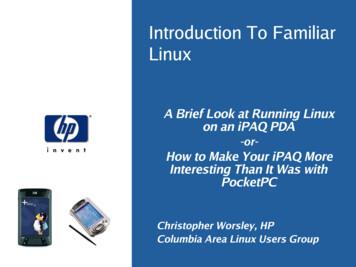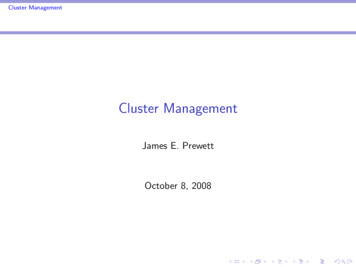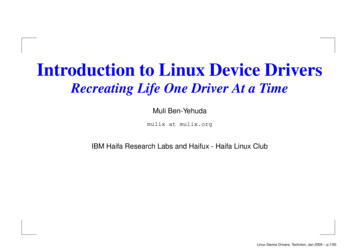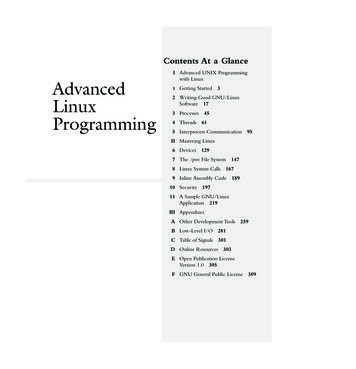
Transcription
Introduction To FamiliarLinuxA Brief Look at Running Linuxon an iPAQ PDA-or-How to Make Your iPAQ MoreInteresting Than It Was withPocketPCChristopher Worsley, HPColumbia Area Linux Users Group
Agenda BackgroundPDA Hardware DescriptionLinux-on-iPAQ SpecificsAvailable ApplicationsWhy Do This To Yourself?Software Development ConsiderationsInteracting with the iPAQSample ScreensFuture Trends05/08/06page 2
Background HP’ s Cambridge Research Laboratory (CRL) in Bostoncreated the “ Familiar” Linux distribution to run on iPAQPDAs in 2001. Although CRL used Familiar Linux for their projects, theproducts group declined to make it a mainstreamchoice for iPAQs. CRL worked closely with the open-source community:– Actively developed the distribution,– Hosted several developer conferences,– Hosted handhelds.org for wiki and CVS server.05/08/06page 3
Background Today, development has transitioned entirely from HPto the open-source community. Handhelds.org is a non-profit company managed byGeorge France. The Familiar Linux community is a small contingent ofdedicated developers and interested companies. Efforts are focused on models like the hx2000s, hx4700and the hx6000s.05/08/06page 4
Know Thy HardwareFamiliar Linux runs best on those iPAQs where: HP is able to make information public. Sometimesconsortium constraints, such as SD, means that HP isunable to release documentation on a particularinterface. A comprehensive amount of information about theperipherals is available (like PCMCIA). The results of reverse-engineering efforts have beenposted to the web: xda-developers, sdgsystems.05/08/06page 5
Just A Computer with mystery components! A PDA is a computer with (mostly) fixed peripherals. PCMCIA services allow for plug-and-play in the CFslots. Some peripherals may be specifically developed forPDA OEMS and have a unique interface (video, wifi,SD). Some peripheral vendors are open-source friendly andprovide detailed specifications in order to facilitateLinux device driver development.05/08/06page 6
Typical PDA Computer Architecture 32-bit CPU Speed ranges between 208MHz to 624MHz. With suchminimal speeds, CPU will be pegged running an application. Speed is a trade-off with battery life. Fortunately most PDAapplications don't require raw horsepower. ARM CPUs offer many power control features such asTurbo Mode (peak frequency), Run Mode (bestpower/performance trade-off), Idle Mode (activity lull), SleepMode (can still maintain I/O state and RTC). Examples:- Intel StrongArm SA1110,- X-Scale PXA250, PXA270,- Texas Instruments OMAP 1510.05/08/06page 7
Typical PDA Computer Architecture Memory ROM: Amount of ROM depends on model. Generally,the range is 32MB to 48MB. The flash ROM holdsPocketPC and is replaced with Linux. RAM: typically 64MB for OS & applications. Running'free' on a 3870 with no apps running yields:root@iPAQ3870: # 28Swap:000Total:63380311683221205/08/06page 8
Typical PDA Computer Architecture Meida, Wireless, etc. Media: Secure Digital (SD), MMC, Compact Flash. Basic integrated wireless:- 802.11 B (networking),- Bluetooth (printing, networking, GPS, etc.),- Infrared. New generation offers even nicer wireless: GSM/GPRS& GPS! Other integrated peripherals include touch-pad, highfidelity audio, microphone, light sensor, client-side USB,& a camera on some models.05/08/06page 9
iPAQ 3000 and 5000 SeriesBuilt during the 2001-2003; recall that: CF was dominant & still relatively expensive,SD & MMC were fledgling with no clear leader,Wireless networking was relatively new.–––Microsoft PPC 2002 or 2003.CPU: 36/37/3800s - Intel StrongArm 1110 @ 208MHz,3900 & 5000s - Intel XScale 250 @ 400 MHz.––Expansion sleeve permits things like: WiFi,Compact Flash storage.–– Familiar Linux runs great on these models!–––05/08/06A lot of attention from CRL,General PDA buzz at that time,Hardware details and interfaces are now wellunderstood yielding improved drivers over time.page 10
iPAQ 2000, 4000, 6000 Series The 2000s and 6000s are the current models. The4700s recently reached end-of-life.In general, PDAs are moving towards a convergeddevice with more and more integrated componentsthat allow for basic organizer (traditional PDA stuff),music, corporate email communications andtelephony.CPU: Mostly Intel XScale, but some TI OMAP.Microsoft PocketPC 2003 or Windows Mobile 5.Familiar support looking good, but not even acrossall models. IMHO, best supported model is hx4700.05/08/06page 11
Linux-on-iPAQ SpecificsVersion 0.8.4 of familiar will be released soon (rc1 is out now).Some iPAQs will stay at 2.4 kernel series while more capableiPAQs use 2.6-based kernels.Filesystems: JFFS2 for root,FAT for removeable media,SMBFS and NTFS for access to files over the network,/tmp is in RAM and therefore really is temporary.––––Networking: –– IPv4 and IPv6,Ethernet over USB.Use of cardmgr and PCMCIA services for expansion sleeves.Serial ports: console, bluetooth, IR./proc has special entries for access to things like the modelnumber, unit serial number, light sensor value, etc.05/08/06page 12
Development ConsiderationsGUI components are built for either Opie or GPE: Software development for iPAQ is the same as any otherLinux platform for daemons, server processes, etc.Use gcc on a host (typically x86) machine and crosscompile for the target. This means that an ARM version ofall your libraries must be available. 05/08/06page 13
Linux on a PDA? Why Do This? Because you can! Stated differently: novelty.Same Unix/Linux API, programming model, and tool suiteknown by lots of developers.Great experience developing embedded ARM applications.Incredible choice of applications available:– Web browsers,– Web servers (yes, Apache has been compiled for ARM!),– Audio players,– IM clients,– Email clients,– SSH server,– NFS,– Samba server and client,– VOIP,– Festival text-to-voice software from Carnegie Mellon.05/08/06page 14
Sample Screens:Configuring eth0 & Using Konqueror05/08/06page 15
Sample Screen: Games05/08/06page 16
Sample Screens:GPE Web Browser and Gaim Application05/08/06page 17
Sample Screens: Showing Off GPE05/08/06page 18
Next StepsHandhelds.org was recently separated entirely from HPand established as a non-profit.Many from HP-CRL have moved to Nokia in Bostonand continue to work in embedded Linux.Momentum and experience from PDAs will help thenew generation of Linux-based Ultra-Mobile PCs(UMPC) such as the Nokia 770. Embedded Linux continues to see major growth inmobile phone market.05/08/06page 19
May 10, 2006 · 05/08/06 HP presentation template user tutorial page 6 Just A Computer with mystery components! A PDA is a computer with (mostly) fixed peripherals. PCMCIA services allow for plug-and-play in the CF slots. Some peripherals may be specifically developed for PDA OEMS and have a unique interfac










